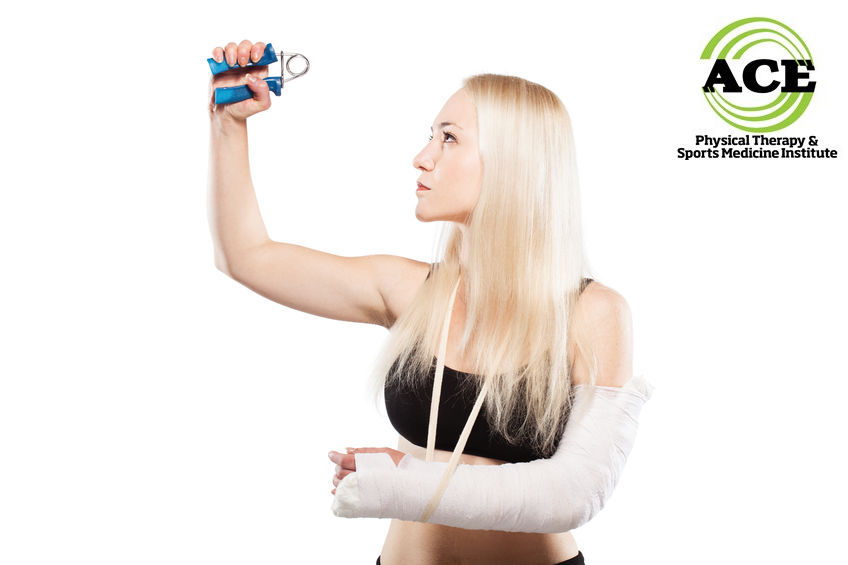CONTRALATERAL TRAINING IN PHYSICAL THERAPY
 Contralateral Training In Physical Therapy
Contralateral Training In Physical Therapy
by ACE Physical Therapy and Sports Medicine Institute
Tid Bits of Info.
- Ipsilateral means same side and contralateral means opposite side.
- Some studies indicate that contralateral strength training can produce results that are upwards of 50% strength gain in the opposite side.
- Muscle atrophy can occur in 3 weeks.
- Contralateral training has been shown to reduce the effects of delayed onset muscle soreness (DOMS).
- Seek the advice and treatment of a Physical Therapist for proper rehabilitation of all injuries.
Some injuries or procedures restrict motion in certain body parts and this can cause a dramatic loss of motion and strength in a short time. Physical Therapists address this challenge for patients in recovery. Over 100 years ago, several healthcare professionals proclaimed that exercising the opposite or contralateral side of the injured body can help to stave off some of these negative changes. Recently, more research is going into the efficacy of this theory, and some believe that it has significant promise with certain patient populations.
Some injuries or procedures restrict motion in certain body parts and this can cause a dramatic loss of motion and strength in a short time. Physical Therapists address this challenge for patients in recovery. Over 100 years ago, several healthcare professionals proclaimed that exercising the opposite or contralateral side of the injured body can help to stave off some of these negative changes. Recently, more research is going into the efficacy of this theory, and some believe that it has significant promise with certain patient populations.
The human body works similar to a machine that needs both halves working together in unison to get the desired results and outcomes. The nervous system is responsible for maintaining the “timing” of all of the motions and movements that have to occur in a synchronized manner for the body to move smoothly. The nervous system can elicit motion from the brain or the spinal cord level. The motions that originate in the brain (motor cortex) are able to be controlled but the spinal cord level motion occurs in the form of a reflex. The reflexive motions are not controllable. The muscles of the body are responsible for movement, but if they do not get a proper signal from the nervous system’s motor cortex, they will not contract in a way that enables them to produce coordinated motion.
Knowing that the body, particularly the nervous system, wants to maintain symmetry within the body’s movement patterns enables the healthcare provider the opportunity to attempt to train the uninvolved side to stimulate results in the involved body part. Training variations such as intensity and contraction type of the uninvolved limb will produce different results in the involved body part, but the results usually average approximately 1/3 of the strength gain that the uninvolved limb experiences. Therefore, the crossover effect of training can initiate the process of developing strength in the involved body part while it may not be able to be actively exercised in the rehabilitation process. Studies indicate that the best results of contralateral training occur with high intensity, highly cognitive activity. When the body is physically challenged and the nervous system is “over-loaded” with challenging tasks such as to control the movements of the body during difficult activities or maneuvers there seems to be a result of crossover that is not present with less intense exercise.
Physical Therapists utilize the crossover effect of exercise and rehabilitation nearly every day and in some cases are not aware that they are doing it. In almost every instance of rehabilitation, the patient is asked to perform exercises with both body parts simply to maintain symmetry in motion. For instance, when a patient is rehabilitating a shoulder injury, they are asked to perform various exercises while watching their shoulder motion in a mirror. They are instructed to perform “symmetrical” motion with their shoulders and not to attempt to move beyond a point that produces abnormal shoulder movement because this might develop poor movement patterns. Simply having the patient maintain symmetry in motion is utilizing the crossover effect of training.
In the future, if a patient is rehabilitated for an injury or a neural injury there is some credence to initiating a rehabilitative program that will involve strength training the uninvolved body part or limb to produce a positive strength gain in the involved body part even if it is unable to move actively.
Seeking treatment from a Physical Therapist is easy. The patient does not have to see a doctor before going to the Physical Therapist. They are licensed healthcare professionals that can be first line providers in every state. The patient might need an insurance referral but does not need a doctor’s prescription to attend Physical Therapy.
Contralateral training has been around for a very long time but until recently it has not been a mainstay of rehabilitation. It appears that conditioning the uninvolved side of the body will have a positive effect on the involved side. At the very least there is no harm in performing a structured exercise program with the uninvolved side during the early phases of rehabilitation.
Read more articles on our main website blog at: ACE-pt.org/blog
Vist our main website at www.ACE-pt.org

